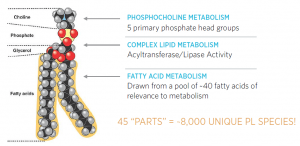 I had an opportunity to follow up with Steven M Watkins, Ph.D. to talk about the importance of studying lipids in disease. Steve has been working in the lipids field for over 20 years and is one of the foremost experts in lipid biology. Steve founded Lipomics in 2000, an early metabolomics company focused on quantitative lipidomics and had followed that company through a series of changes that led to its involvement in the clinical diagnostic development and global metabolomics. Steve authored over 70 peer-reviewed publications including several book chapters on lipids and lipid metabolism. His presentations on this topic are fascinating and very informative, so I wanted to capture some of his thinking here!
I had an opportunity to follow up with Steven M Watkins, Ph.D. to talk about the importance of studying lipids in disease. Steve has been working in the lipids field for over 20 years and is one of the foremost experts in lipid biology. Steve founded Lipomics in 2000, an early metabolomics company focused on quantitative lipidomics and had followed that company through a series of changes that led to its involvement in the clinical diagnostic development and global metabolomics. Steve authored over 70 peer-reviewed publications including several book chapters on lipids and lipid metabolism. His presentations on this topic are fascinating and very informative, so I wanted to capture some of his thinking here!
Baljit: Why is it important for us to study metabolomics, and why specifically should we focus on studying lipids?
Steve: There are a number of really important reasons to study metabolomics. First, it is really metabolomics that integrates the effects of our genes and the impact of the environment. The metabolome is the product of both internal factors (our genome and proteome) and external factors (our lifestyle and our environment) and therefore is a very good readout of the complete status of a given biological system. The metabolome is also dynamic and therefore we can monitor changes over time that will reflect how the biological system is impacted by various perturbations. The metabolic pathways are also extremely well understood; they form the cornerstone of biological knowledge in the life sciences. So if we can identify and quantify changes in specific metabolites, we can study perturbations and map these back to a pathway for detailed interpretation.
Lipids are a key part of the metabolome but a very complicated, diverse part of the metabolome. The structures of lipids drive the formation of important biological elements, membranes, lipid droplets, lipoproteins. They act as signaling molecules, inflammatory molecules and are known to be key in some disorders including metabolic disorders, cardiovascular disease, oncology and others.
Baljit: What are the challenges of studying lipids?
Steve: Lipids are very different from the rest of the metabolome. They are complex polymers that are formed by combining metabolites that come from different metabolic pathways. They are combinatorial products of fatty acids and head groups and can often have the same mass. So if you imagine there are 40 different fatty acids and five main head groups, these 45 components could account for 8000 unique phospholipid species! Pathway mapping is possible using all species, but it would be so complicated that it would have minimal biological meaning.
Baljit: So what is the best way to try and understand lipid biology?
Steve: So when we study the complexity of the lipidome, we need to think about lipid metabolism as a 2D matrix rather than a list of individual species. So across the top of the matrix, we have different lipid classes with different lipid head groups (triglycerides, phosphatidylcholines, cholesteryl ester) and the rows are all the different possible fatty acids that could be attached in different combinations. If we want to understand the biology, we must be able to measure both the class of the lipid as well as the fatty acid composition changes within that class to develop the whole picture. As an example, if there is a perturbation in the activity of one of the enzymes important in fatty acid metabolism (changing the abundance of a specific fatty acid), this will actually create a change in that fatty acid level across all lipid classes, across the whole row. Or if we have a change in activity of an enzyme that impacts the amount of a specific lipid head group, then we will see a change in the whole column.
Baljit: So when you think about an analytical system for studying lipid biology, what would it need to deliver?
Steve: So the goal would be to generate a complete quantitative lipid profile of the biological system. We would want to know the concentration of lipid classes (the columns), fatty acid composition across those classes (the rows) and the individual molecular species themselves (each square). To do this, we need our solution to deliver three things:
We need Specificity to be able to study a specific lipid class and identify the full fatty acid composition within it. We don’t just want to know we have a phosphatidylcholine species with 36 carbons and two double bonds; we want to know exactly which specific fatty acids were present in that PC molecule to be able to map back to the matrix.
We need Quantitation, so we can measure how much of each species is present so we can accurately sum across rows and columns of our matrix.
And we need Coverage; we need a comprehensive method to identify and quantify all the lipid classes and the fatty acids that comprise those classes. This lets us really dig into to understand what change in the biology is producing the change in the lipid profiles.





0 Comments